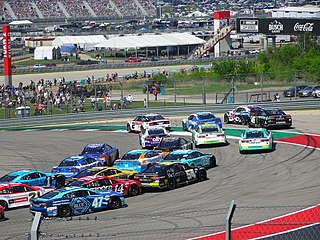
Auto racing is a motorsport involving the racing of automobiles for competition. In North America, the term is commonly used to describe all forms of automobile sport including non-racing disciplines.

Drag racing is a type of motor racing in which automobiles or motorcycles compete, usually two at a time, to be first to cross a set finish line. The race follows a short, straight course from a standing start over a measured distance, most commonly 1⁄4 mi, with a shorter, 1,000 ft distance becoming increasingly popular, as it has become the standard for Top Fuel dragsters and Funny Cars, where some major bracket races and other sanctioning bodies have adopted it as the standard. The 1⁄8 mi is also popular in some circles. Electronic timing and speed sensing systems have been used to record race results since the 1960s.

The National Hot Rod Association (NHRA) is a governing body which sets rules in drag racing and hosts events all over the United States and Canada. With over 40,000 drivers in its rosters, the NHRA claims to be the largest motorsport sanctioning body in the world.

Donald Glenn Garlits is an American race car driver and automotive engineer. Considered the father of drag racing, he is known as "Big Daddy" to drag racing fans around the world. A pioneer in the field of drag racing, he perfected the rear-engine Top Fuel dragster, an innovation motivated by the loss of part of his foot in a dragster accident. This design was notably safer since it put most of the fuel processing and rotating parts of the dragster behind the driver. The driver was placed in front of nearly all the mechanical components, thus protecting him and allowing him to activate a variety of safety equipment in the event of catastrophic mechanical failure or a fire. Garlits was an early promoter of the full-body, fire-resistant Nomex driving suit, complete with socks, gloves, and balaclava.

Top Fuel is a type of drag racing whose dragsters are the quickest accelerating racing cars in the world and the fastest sanctioned category of drag racing, with the fastest competitors reaching speeds of 341.68 miles per hour (549.9 km/h) and finishing the 1,000 foot (304.8 m) runs in 3.62 seconds.
Motorsport(s) or motor sport(s) are sporting events, competitions and related activities that primarily involve the use of automobiles, motorcycles, motorboats and powered aircraft. For each of these vehicle types, the more specific terms automobile sport, motorcycle sport, power boating and air sports may be used commonly, or officially by organisers and governing bodies.
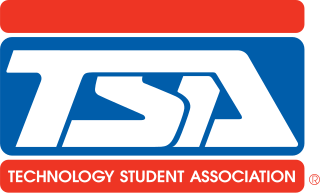
The Technology Student Association (TSA) is a national non-profit career and technical student organization (CTSO) of over 300,000 middle and high school student members engaged in science, technology, engineering, and mathematics (STEM). TSA's mission is to enhance personal development, leadership, and career opportunities in STEM, whereby members apply and integrate these concepts through intracurricular activities, competitions, and related programs.
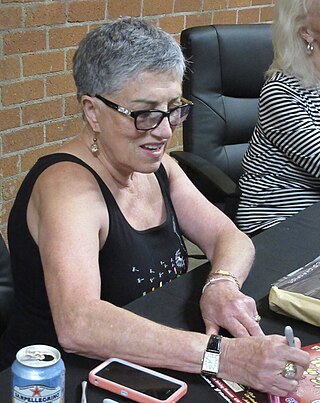
Shirley Muldowney, also known professionally as "Cha Cha" and the "First Lady of Drag Racing", is an American auto racer. She was the first woman to receive a license from the National Hot Rod Association (NHRA) to drive a Top Fuel dragster. She won the NHRA Top Fuel championship in 1977, 1980, and 1982, becoming the first person to win two and three Top Fuel titles. She won a total of 18 NHRA national events.

A water rocket is a type of model rocket using water as its reaction mass. The water is forced out by a pressurized gas, typically compressed air. Like all rocket engines, it operates on the principle of Newton's third law of motion. Water rocket hobbyists typically use one or more plastic soft drink bottles as the rocket's pressure vessel. A variety of designs are possible including multi-stage rockets. Water rockets are also custom-built from composite materials to achieve world record altitudes.
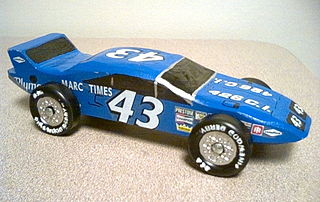
The pinewood derby is the wood car racing event of the Cub Scout Program of the Boy Scouts of America. Pinewood derbies are often run by packs of the Cub Scouts program. With the help of adults, Cub Scouts build their own unpowered, unmanned miniature cars from wood, usually from kits containing a block of pine wood, plastic wheels, and metal axles. With the popularity of the pinewood derby, other organizations have developed similar events. Pinewood derby is a registered trademark of the BSA, so most use different names. Each derby has slightly different rules for making and racing their cars. A small industry has developed to provide organizer equipment and awards.
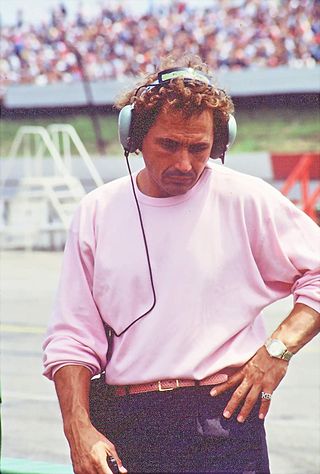
Kenneth Dale Bernstein is an American drag racer and former NASCAR and IndyCar team owner. He is nicknamed the "Bud King" for his success in the Budweiser King funny car and dragster. He has also been nicknamed the "King of Speed," because he was the first driver to break 300 miles per hour in the standing-start quarter mile. Bernstein owned King Racing, which he drove for in the NHRA and fielded various cars in other racing series such as IndyCar and NASCAR. Bernstein retired from full-time competition in 2002 and moved his son Brandon into the Bud King Top Fuel dragster, but returned to finish the season in place of his son after Brandon suffered a severe injury. With the exception of a brief return to Funny Car in 2007, Bernstein did not return to the car and instead continued to run his team until the end of the 2011 season when he left drag racing altogether.

Brainerd International Raceway is a road course, and dragstrip racing complex northwest of the city of Brainerd, Minnesota. The complex has a 0.25 mi (0.40 km) dragstrip, and overlapping 2.500 mi (4.023 km) and 3.100 mi (4.989 km) road courses. The complex also includes a kart track. The raceway hosts the National Hot Rod Association's Lucas Oil Nationals. It is a popular racetrack for the Trans Am Series. The spectator seating capacity of the circuit is 20,000.
Nostalgia drag racing is a form of drag racing that uses cars from earlier eras of drag racing, as well as cars built to fit the guidelines of earlier eras using parts that would have been available in that era.

Sydney Herbert Allard was the founder of the Allard car company and a successful rally driver and hillclimb driver in cars of his own manufacture.
Solar car racing refers to competitive races of electric vehicles which are powered by solar energy obtained from solar panels on the surface of the car. The first solar car race was the Tour de Sol in 1985 which led to several similar races in Europe, US and Australia. Such challenges are often entered by universities to develop their students' engineering and technological skills, but many business corporations have entered competitions in the past. A small number of high school teams participate in solar car races designed exclusively for high school students.
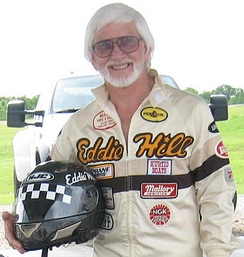
Eddie Hill is an American retired drag racer who won numerous drag racing championships on land and water. Hill had the first run in the four second range (4.990 seconds), which earned him the nickname "Four Father of Drag Racing." His other nicknames include "The Thrill", "Holeshot Hill", and "Fast Eddie". In 1960, he set the NHRA record for the largest improvement in the elapsed time (e.t.) when he drove the quarter mile in 8.84 seconds to break the previous 9.40-second record.
The following is a glossary of terminology used in motorsport, along with explanations of their meanings.
Electric drag racing is a form of drag motor racing between electric vehicles.

A dragster is a specialized competition automobile used in drag racing.

Josh Hart is an American race car driver and entrepreneur. He is founder of Burnyzz Speed Shop in Ocala, FloridaHe also owns and drives the R+L Carriers / TechNet Professional NHRA Top Fuel Dragster in the NHRA Mission Foods Drag Racing Series.
















